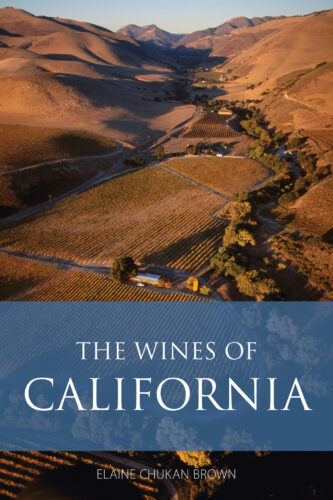Book Review
You may not get exactly what you expected when you open The Wines of California, a new encyclopedic work by well-known wine expert Elaine Chukan Brown. And that’s good.
Before diving into details of grapes, climate, geography and regions, Brown begins the conversation with several centuries of early Spanish and Indigenous Californian history. Cultural and political elements are interwoven throughout the book, presenting us with both macro and micro lenses to view California wine—and the wine industry as a whole—in the past, present and future.
Equally interesting is Brown’s own history. (Please click on this link to their bio, otherwise I would have to take up all the space I have in this article describing their journey from native Alaskan upbringing, to philosophy professor in Arizona, to their current position as an award-winning Sonoma-based wine writer.)
Over a dozen years ago I began following Brown’s online persona hawk_wakawaka. Knowing nothing about them, not even their name, I was drawn by their insightful writing and inimitable outlook.
When Brown and I met on zoom the other day we had a wide-ranging discussion from the point of view that wine and grapes are part of the land, air, water, sun, animals, insects, people and everything else on this planet. As obvious as it may seem, this approach to wine wasn’t (and often still isn’t) a consideration for many of us. Instead, the end-product—the bottle of wine—is too often our sole focus. How it got here is not always part of the story for writers and consumers, and it needs to be.
IN THE BOOK
Brown does an incredible job of encompassing all the elements involved in wine. Though California is unique, it is also emblematic of the worldwide wine industry in its agricultural, production, financial, regulatory and climatic development issues.
The Wines of California contains a full compendium of historical timelines, descriptions of wine regions and AVAs, maps, climate, weather and topographical info, along with Brown’s selection of the most significant wineries in each area. While Brown usually exceeds expectations, there is one small thing I missed having here: all the dates that Brown’s selected wineries were established. For me, this would add important context to California wine history.
Brown explains how we celebrate successes but often forget about the many challenges people have had to overcome in order to succeed, and how that could help us. You can see this in repeated cycles of vineyard diseases as well as poor treatment of marginalized people. Both are issues that no one paid enough attention to as they evolved, until too late.
PRESENT AND FUTURE—A DISCUSSION
Recently, there’s been a downturn in wine consumption. Most likely, this is a normal variation within our documented 8,000 years of wine and its generational and cultural fluctuations. More specifically, Brown points to a neo-prohibitionism movement that echoes developments of the late 1800s and early 1900s. It is augmented by political and individual divisiveness, as well as by a deliberate dissemination of more health misinformation than material evidence.
Brown discusses the ramification of 20th century Prohibition, which altered the trajectory California’s agricultural and wine businesses, as well as social norms throughout the country. Instead of repeating this cycle, in today’s conflicted world Brown believes in leading by example. In not trying to simplify issues, but rather attempting to clarify them.
Though there are many problems to overcome in the wine world, Brown shines a light on the rapid improvements possible in many areas. They have personally seen a difference in only five years of treating vineyards better, by, for instance, grazing sheep between the rows of vines instead of regularly using machines, chemical pesticides and fertilizers. In terms of water issues, they relate how it took only two weeks after removing river dams for salmon to repopulate streams they had been cut off from, for decades. Would any of this have been possible without someone taking a leap to try something new?
Brown believes that “In human communities, welcoming diverse perspectives invites a broader range of first-hand knowledge and experience…California has demonstrated again and again the determination of its people to fight for positive change, even as its history includes innumerable obstacles and harms.”
BACK TO THE BOOK
In their epilogue “Regeneration and Innovation” Brown offers hope for the future, bright glimmers on the pathway from the difficulties of yesterday and today, to a better place in the future wine universe.
This is a definitive work, including valuable appendices such as wine label requirements, farmworker protections, sustainability certifications, and an explanation of the three-tier system of wine distribution in the US.
Overall, this book is an illustration for the famous quote about why we study history: if we don’t, we are doomed to repeat it.
HOW TO USE THIS BOOK
This is a large book, but don’t let that stop you. My advice is to use it on a day-to-day basis, to look up anything about wine you’re wondering about. Or just scroll to a random page, read it, and you’ll learn something—often something you didn’t know you needed to learn.


